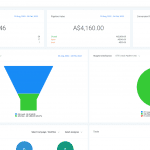When you work with a digital marketing agency, one of the first key areas of focus should be to build a database of email subscribers.
This is especially important if you sell a high-end product or service and have a longer buyer journey, as it gives you the chance to communicate your expertise and keep yourself front of mind as your potential customers work through the decision-making process.
It takes time and effort to build your email subscriber list, so once you have one, it’s important to make the most of it. The challenge here is to not just keep your subscribers engaged, but to also turn them into your biggest fans.
The good news is that writing, sending and tracking effective emails doesn’t need to take up too much of your time, yet it yields some amazing results. In fact, over the past six years, we’ve successfully built one client’s database from 650 contacts in 2015 to more than 30,000 email subscribers today. And that’s AFTER doing regular cleanups of the list to remove inactive contacts.

Now we’ve uncovered what works, we only spend a small amount of time each week creating, sending and tracking emails. The result is potential customers who are more educated about what they want and more convinced that our client can deliver it, visiting the site on a weekly basis to read the latest content we’re publishing. Which is exactly why email lists are so valuable!
Over the last 12 months we’ve sent over 1 million marketing emails on behalf of our clients, and in this article we’ll share some of the insights we’ve gained as a result.
Here are the four key factors you need to get right to make email marketing work, with some top tips that show you how we do it for ourselves and our clients.
The right frequency for your marketing emails
Getting the timing right on your emails is key to maximising the impact and minimising unsubscribers.
Leave it too long between emails and you’ll be forgotten, but send too many and you risk annoying people. The ideal frequency will vary depending on your business and the quality of content you have to share, but for this client who’s a home builder, we’ve found weekly works well. For others in a more specialised field, fortnightly or even monthly might be a better option. Whatever you choose, make sure your cadence is regular and that you stick to it.
Proven tip: For our home builder client, a predictable Saturday morning email every week works really well, as they have many interesting topics to cover and the audience wants to gather lots of information before they make a decision. However, if you have limited subject matter to cover or your audience already has a good understanding of what you do, fortnightly or even monthly will likely be enough.
Timing your email sending to perfection

The other big decision is the day and time for when you schedule your email.
Your best bet is to try a few different days and times to see when you get the best response. If you do this, be sure to give each time slot a minimum of three emails before you change it. If you’re not sure where to start, for B2B we often recommend Tuesday, Wednesday and Thursdays as the best days for sending, ideally between 10am and 2pm, as this is when people are often more receptive to opening their emails at work.
However, for our B2C clients, outside of working hours works well, as the subject matter is often best digested over a cuppa rather than while on the go or at work. Evenings can work best for some businesses, so have a think on when your ideal clients will be most receptive to what you have to say.
Free Content Upgrade: If you’re wondering HOW to get all these people on your email list in the first place, download our free guide on 50+ lead magnet ideas you can deploy in your business today to start building a giant email list of engaged prospects.
Pro tip 1: You may need to try a few different days and times before you settle on your ideal timeslot. Saturday morning works well for our home builder client as it allows readers to browse the email leisurely as they imagine how their new home might look and long-term subscribers look forward to their weekly dose of inspiration at 9:30 am. For B2B businesses, a weekday slot would work better, as they are far less likely to want to be thinking about work things on their day off.
Pro tip 2: Take a look at the big players in your industry and see when THEY send out their marketing emails. Is it first thing in the morning, middle of the day, or in the evening? If they’re a big (local) brand then chances are they’ve already tested various sending times and figured out what works best. There’s no need to reinvent the wheel in this case, just send your emails at the same day/time as your big brand counterparts.
Engaging and informing Marketing Emails
If you’re like most people these days, your inbox is overflowing with marketing emails on a daily basis, so to get noticed and get opened the emails you send have to include something of real value. This doesn’t need to be in the form of a special offer or discount – good, relevant information that will help them make an informed decision can be far more valuable, especially when it comes to big ticket purchases.
While it’s a good idea to include some soft CTAs in your email, this is (usually) not the time or place to push hard for a sale. Instead, your aim should be to share useful information on an interesting topic that is relevant to your audience while also showcasing your expertise.
A simple and effective option is to write an email that accompanies your new blog posts. That way, you’ll alway cover a key area of interest without the need to reinvent the wheel. The blog post also provides the perfect call to action to click through to your website.
Proven tip: Our client’s weekly email has always worked well tied in with their weekly blog post, so when they dropped their blog posts back to fortnightly, we were unsure whether to do the same with the emails. However, because they have a large catalogue of published blog posts on their website, we decided to pick an older post to promote in the email every fortnight instead. This has worked really well, giving the past blogs a new audience and providing us with a whole new place to draw content from. Interestingly, we don’t notice a big difference in open and click rates when we compare new topics to old, it’s more to do with the subject matter itself. For example, we always see much higher numbers when the topic is project or design related, compared to more specific topics on more specific, mundane (but important) topics.
Format and layout of Your Email Matters
The final key element to consider is how your email will look. You can opt to send anything from a short, sharp extract-style email to a longer form letter-style email that includes more detail.
To find out what works you can try both for a few weeks each to see which gives you the best results. You’ll also need to decide who the email will come from – will it include your personal sign-off or a generic company signature? In our experience, a personalised signature is best.
Proven tip: This is one area where we have tried a few different things to maximise the open and click through rates and we’ve found small tweaks can have a big impact. For example, we added an image to the email and broke up the text with teaser dot points, which both had a positive impact. On the other hand, when we changed the link to the related article from a full sentence in bold on its own line, to a less obvious click through in the text, the clicks dropped quite dramatically, so we quickly switched back and saw the numbers increase accordingly.
Tracking what works with Email Marketing

Of course like any marketing methods, you need to be able to see and analyse the data to know what’s working and what’s not. Most of our clients use HubSpot, as it’s the ideal all-in-one solution where we can draft and send emails, see how leads and opportunities interact with the content, and access a whole range of other useful analytics.
HubSpot also allows us to create email nurture workflows, exclusion lists and utilise other handy features to personalise campaigns to suit our clients’ varying needs, which is why HubSpot is our tool of choice. You can of course use any tool that works for you, as long as you can pull the key information out to analyse the results, namely open rate, click rate and click through rate.
Proven tip: While open rate (the percentage of people who open your email) and click rate (the percentage of people who clicked a link in your email of those who received it) are the two most widely analysed metrics, we find the click-through rate a really good indication of how effective the email is. The click-through rate measures the percentage of people who click a link in the email from those who opened it. So for example, in the most recent email we sent for our client, of the 24,180 people who received the email, 21.3% (5139 contacts) opened it. Of those 5139 people, 26.4% (1357) clicked a link in the email. This means around 1 in 4 people who opened the email went on to click on a link, which is a great result when compared to the industry average for email click throughs, which is 9.31%.
Maximise the impact of Your Email Marketing
When you get the frequency, timing, content and format right, and can accurately track the key metrics, your emails to subscribers can be a really powerful way to boost your credibility, reputation and importantly, your bottom line. By taking the time to experiment a little to find out works, and being consistent in your delivery once you find the sweet spot, your email subscribers will look forward to hearing from you. Importantly, this puts you in the prime position to win their business when the time is right for them to buy.
Would you like to find out how content marketing, SEO and emails can come together to sustainably grow your business? Apply for a free strategy session today to get started.

- 3 Winning Inbound Marketing Tactics You Can Implement Now - November 17, 2022
- What is a Lead Magnet and Why Does Your Business Need One? - November 15, 2022
- 6 Steps for Being Successful at Business Blogging - October 10, 2022






